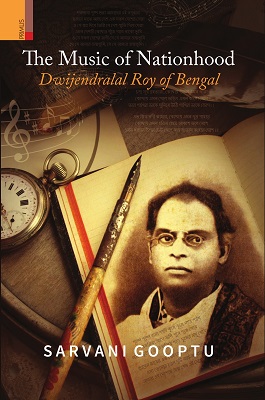
The Music of Nationhood: Dwijendralal Roy of Bengal
EDITOR- Sarvani Gooptu
| HB ₹1195 . $64.95 . ₤52.95 |
||
INFORMATION
- EDITOR : Sarvani Gooptu
- HB ISBN : 978-93-86552-93-8
- Year : 2018
- Extent : 320 pp.
- Discount available on checkout
- Usually dispatched within 3 to 5 working days.
Tagore
| HB ₹ 995 . $ . ₤ |
PB ₹ . $ . ₤ |
|
| POD ₹ . $ . ₤ |
e-Book ₹ . $ . ₤ |
INFORMATION
- AUTHOR –
- ISBN – 978-93-84082-78-9
- Year – 2016
- Extent: 400 + 40 coloured illustrations
- 10% discount + free shipping
- Usually dispatched within 3 to 5 working days.
During his lifetime Dwijendralal Roy (1863-1913) was one of Bengal’s best known poet-musician-dramatists, and his lyrical songs and comic poetry which captured the imagination of the people, were used in historical and social dramas and satires of the period. His songs (called Dwijendra-geeti) combined Western music styles with sophisticated lyrics in Bengali and in doing so marked a breakthrough in the Indian music tradition. Dwijendralal skilfully used historical memory in his plays to highlight values that he considered crucial for the creation of an ideal India nation, based on compassion and integrity. His groundbreaking use of humour and satire to highlight the injustices that bedevilled society in late nineteenth-early twentieth century India won him innumerable admirers. His immense contribution to music and literature notwithstanding, his rich oeuvre has suffered monumental neglect, and there is an appalling lack of awareness about the man and his work. This volume attempts to put that right by documenting as well as undertaking a serious study of the creative genius of this artist.
The Editor
Sarvani Gooptu is Professor of Asian Literary and Cultural Studies at the Netaji Institute for Asian Studies, Kolkata
As a global figure, Tagore transcends the boundaries of language and reaches out to people distant both in time and space. His art took inspiration from contemporary Western trends and became a powerful means to connect with people beyond Bengal. Word, image, song, and text were his tools of communication, as also his extraordinary presence in a sartorial garb of his own design. A littérateur in many genres, the impact of his work was determined both by the material he presented, and by its simultaneously local and global contexts. Now, when his international reputation has spanned over more than a hundred years, it is important to revisit the sites of Tagore’s eminence, and ask to what extent he was a ‘living text’ in the century that witnessed him as a global intellectual.
Accordingly, this volume investigates how Tagore’s writings and art are linked to the metalinguistic domains of the psychological, medical and mythical; how he was received in various cultures outside India; how his art was determined by individual circumstances and global aspirations; and how he acted as an inspiration to his contemporaries and subsequent generations including modern Indian writers and artists.
The Editor
Imre Bangha studied in Budapest and Santiniketan and at present is Associate Professor of Hindi at the University of Oxford. He has published books and essays in English, Hindi, and Hungarian on literature in Brajbhasha and other forms of old Hindi and has also prepared Hungarian translations from various South Asian languages. His work on the international reception of Bengali culture includes Rabindranath Tagore: Hundred Years of Global Reception (2014, co-edited with M. Kämpchen) and Hungry Tiger: Encounter between India and Central Europe (2007).
Table of Contents
Table of Contents
| Preface | Ix-Xi |
| Introduction | Xiii-Xxvi |
| The Life And Times Of Dwijendralal Roy: The Sources Of Inspiration | 1-35 |
| The Problem Of Patriotism In Verse And Song | 36 |
| Imagined History: A Study Of The Plays | 67-103 |
| Gentlemanly Laughter As A Weapon | 104-148 |
| The Impact Of Western Music On Metre And Music | 149-219 |
| Performance Of Dwijendralal’s Play | 220-239 |
| Conclusion | 240-260 |
| Appendices | 261-275 |
| Bibliography | 277-285 |
| Index | 287-294 |




